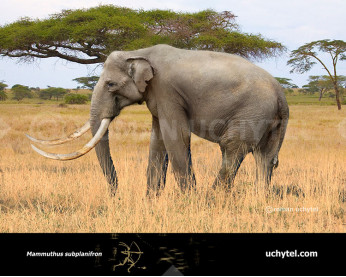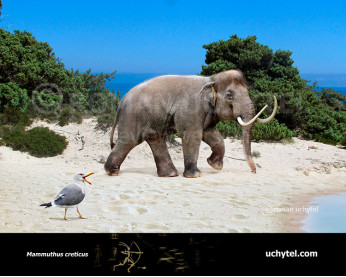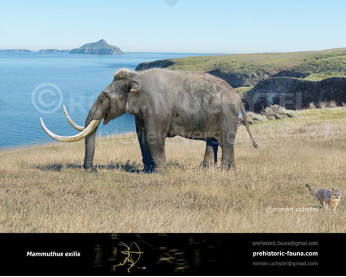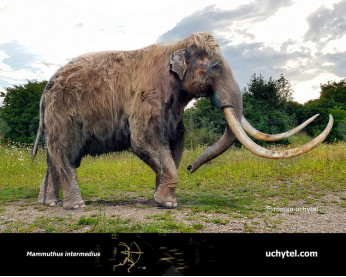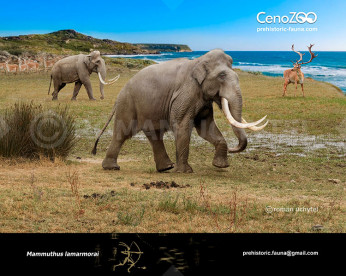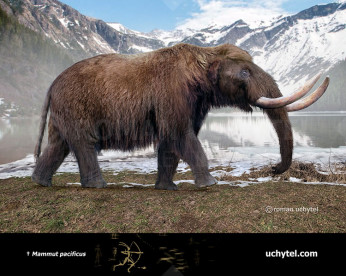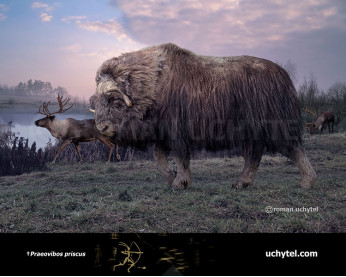The most recent survival of all known mammoth populations (Wrangel Island)
1000000007510000000075
The pygmy Woolly Mammoth from Wrangel Island (Mammuthus primigenius (Blumenbach, 1799))
Order: Proboscidea
Family: Elephantidae
Dimensions: length - 3,2 - 4 m, height - 2,1 m, weight - 1700 - 3000 kg
Temporal range: during the Late Pleistocene - Holocene epoch (4,000 years ago, Wrangel Island)
Siberian or woolly mammoth - one of the most recognizable extinct mammals and most characteristic of large animals of the Quaternary period. Its whole body is covered with a thick coat with a dense undercoat: the length of hair on the shoulders, flanks and hips reached 70 cm, forming a kind of fringe observed in modern yak. Coat color changed from black-n-brown to reddish; cubs were painted lighter. The head was massive, with relatively shorter trunk and furry little ears; located on the back of a fatty hump (additional adaptation to the cold climate). The evidence of intensive use its tusks are traces of abrasion even in teenage individuals. Lifestyle and social structure of mammoths were apparently similar to what can be observed in the surviving elephants today. The habitat of the mammoth - is open grassy plains, as the characteristic landscape of the late Pleistocene considered tundra, combines the features of a modern tundra and forest-steppe. In connection with a characteristic sequence of animals, this giant ecosystem stretching from Britain to Alaska, also called the "mammoth steppe" . Its vast areas were heterogeneous in productivity, and the most fodder places are river valleys. For late Pleistocene - early Holocene was characterized by abrupt climate changes.
According to the scientists, explore the ancient climate, these very changes have led to the disappearance of the typical representatives of the mammoth fauna in the vast territory. The sharp decline in the number and distribution of the woolly mammoth occurred during the last glaciation attenuation, from 16000 to 9500 years ago.
The last known population remained on Wrangel Island in the Arctic Ocean until 4,000 years ago, well into the start of human civilization and concurrent with the construction of the Great Pyramid of ancient Egypt.
The most likely scenario is "the last straw": during sudden rearrangements of climate with the changes at the glacial climate model to the current interglacial, large animals were concentrated in the "refugia" - relatively small areas with favorable conditions, waiting through the hard times. In previous cycles of glaciation-warming after stabilization of the new climate model, the animals were settled out of these "safe havens" and reduced its numbers, but at the end of the last glaciation Eurasia and the hole world has been populated by highly specialized hunters of the Paleolithic. Naturally, they also come in these remaining "nidi of hunting paradise." As a result of experiencing climatic stress animals, apparently, just do not stand the extra pressure of human hunting and died out completely.
Payment
You may use multiple payment methods to buy image such as credit cards, PayPal and bank transfer.
The pygmy Woolly Mammoth from Wrangel Island (Mammuthus primigenius (Blumenbach, 1799))
Order: Proboscidea
Family: Elephantidae
Dimensions: length - 3,2 - 4 m, height - 2,1 m, weight - 1700 - 3000 kg
Temporal range: during the Late Pleistocene - Holocene epoch (4,000 years ago, Wrangel Island)
Siberian or woolly mammoth - one of the most recognizable extinct mammals and most characteristic of large animals of the Quaternary period. Its whole body is covered with a thick coat with a dense undercoat: the length of hair on the shoulders, flanks and hips reached 70 cm, forming a kind of fringe observed in modern yak. Coat color changed from black-n-brown to reddish; cubs were painted lighter. The head was massive, with relatively shorter trunk and furry little ears; located on the back of a fatty hump (additional adaptation to the cold climate). The evidence of intensive use its tusks are traces of abrasion even in teenage individuals. Lifestyle and social structure of mammoths were apparently similar to what can be observed in the surviving elephants today. The habitat of the mammoth - is open grassy plains, as the characteristic landscape of the late Pleistocene considered tundra, combines the features of a modern tundra and forest-steppe. In connection with a characteristic sequence of animals, this giant ecosystem stretching from Britain to Alaska, also called the "mammoth steppe" . Its vast areas were heterogeneous in productivity, and the most fodder places are river valleys. For late Pleistocene - early Holocene was characterized by abrupt climate changes.
According to the scientists, explore the ancient climate, these very changes have led to the disappearance of the typical representatives of the mammoth fauna in the vast territory. The sharp decline in the number and distribution of the woolly mammoth occurred during the last glaciation attenuation, from 16000 to 9500 years ago.
The last known population remained on Wrangel Island in the Arctic Ocean until 4,000 years ago, well into the start of human civilization and concurrent with the construction of the Great Pyramid of ancient Egypt.
The most likely scenario is "the last straw": during sudden rearrangements of climate with the changes at the glacial climate model to the current interglacial, large animals were concentrated in the "refugia" - relatively small areas with favorable conditions, waiting through the hard times. In previous cycles of glaciation-warming after stabilization of the new climate model, the animals were settled out of these "safe havens" and reduced its numbers, but at the end of the last glaciation Eurasia and the hole world has been populated by highly specialized hunters of the Paleolithic. Naturally, they also come in these remaining "nidi of hunting paradise." As a result of experiencing climatic stress animals, apparently, just do not stand the extra pressure of human hunting and died out completely.

-797x638.jpg)
5-797x638.jpg)
-size-797x638.jpg)
-797x638.jpg)
-70x56.jpg)
5-70x56.jpg)
-size-70x56.jpg)
-70x56.jpg)
-346x277.jpg)
